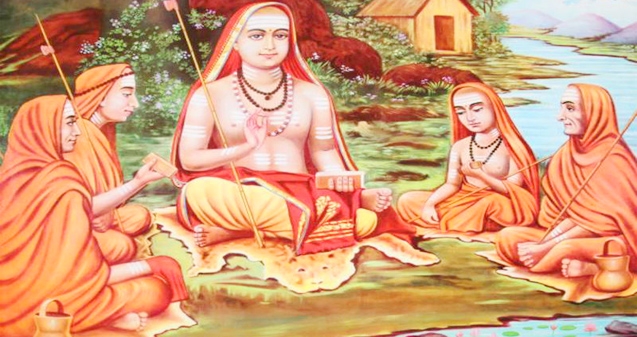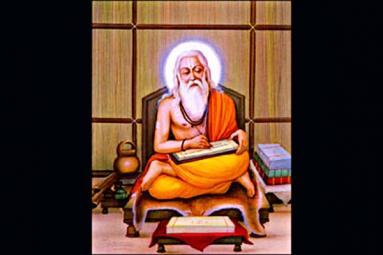
If one has to know about Yajur Veda in simple terms, it basically talks about the various steps by which religious rituals should be performed. It is a step-by-step guide about the right way of performing religious ceremonies and sacred rituals. The word Yajur Veda is a combination of two words, "Yajus" meaning sacrifice and "Veda" meaning knowledge. But when one dwells deeper into the meaning of classical Yajur Veda, one finds that it has much deeper significance than just being a book of rituals. A part of the four Vedas, Yajurveda was the main Vedic script used by the priests in ancient India. Yajur Veda seeks to create a deeper level of consciousness among people. It sets forth a yogic practice that purifies not just the body, but also the mind. This helps in awakening the inner consciousness, which opens up new avenues of learning and understanding of life and existence. To know more about Yajur Veda, continue to read this insightful article on it.
History Of Yajur Veda
The Vedic scriptures are full of mantras that help in religious rituals. The Yajur Veda bears resemblance to the Book of the Dead of Egypt. Contrary to popular belief, it does not help raise the dead, but instead helps the soul of the deceased to lead a comfortable afterlife. The Yajur Veda also emphasizes on the same deities as the Rig Veda but in a different way. The main aim of reciting the sacred hymns is to awake the inner consciousness and bring together the cosmic energies within oneself. This opens up avenues for recreating a universal energy within the human psyche. This cosmic level of consciousness is very necessary in order to lead a life that is both meaningful and satisfying. Once ego and other vices are surrendered to the Divine force, a person can attain higher forms of happiness. But the biggest sacrifice is Self-sacrifice, which helps in the attainment of Moksha, Nirvana or immortality.
Contents Of Yajur Veda
Yajur Veda consists of two major sacrifices: Darsapurnamasa and Asvamedha. The sacrificial ceremony in Darsapurnamasa sacrifice is performed at the new and full moon. The Asvamedha or the horse sacrifice, 609 domestic and wild animals are tied to 21 sacrificial posts. Some of the hymns from Yajur Veda are still very popular in Hinduism. In Hindu mythology, there is a famous story surrounding the Yajur Veda. The student of the great guru Ved Vyas, Vaisampayana, learnt about Yajur Veda from him. Then there was a time when he committed an offence and performed some charms on Ved Vyas’s other disciple called Yajnavalkya. In retaliation, Yajnavalkya attacked Vaisampayana with all the texts from Yajur Veda which he had apparently learnt from Vaisampayana himself. During this fight, the other disciples picked up the broken texts from Yajur Veda recited by Yajnavalkya and jotted them down as Taittiriyas. The very first copy of Taittiriya Samhita from Yajur Veda was first compiled together and published during the time period of 1860-1865 in Bibliotheca Indica by Baboo Rajendralala Mitra frm Kolkata. It was coupled up with the commentary of Sayana or Madhava. The most popular hymn from Yajur Veda–– Gayatri Mantra, is popular to even this day and is used in various auspicious ceremonies and occasions. It is recited to address to the sun god who gives life to everyone and everything on earth and it is mostly recited during sunrise or sunset.
Composition: Yajur Veda is quintessentially divided into two major parts: Shukla or the white Yajur Veda and Krishna or the black Yajur Veda. Both these parts have different kinds of writing in it; Shukla has Shatapatha Brahmana text while Krishna Had the Brahmana prose. Further to this, Shukla Yajur Veda is split into two different parts: Vajasaneyi Madhyandiniya and Vajasaneyi Kanva. They differ in the scope of their popularity; Vajasaneyi Madhyandiniya is more popular in the northern part of India like Nasik, Gujarat, etc. while Vajansaneyi Kanva is more famous in the southern part of India like Orissa, Andhra Pradesh, Tamil Nadu, Karnataka, etc.
Another major difference between the Shukla Yajur Veda and Krishna Yajur Veda is that the white or Shukla Yajur Veda consists only of prayers and formulas of legit sacrifices to the god, uttered by the designated priests or Brahmins while the black or Krishna Yajur Veda consists only the rites and rituals for various sacrifices and discussions on them.
Krishna Yajur Veda or the black Yajur Veda has four different parts: Taittiriya Samhita, Maitrayani Samhita, Caraka Katha Samhita and Kapisthala Katha Samhita. All these parts have a similar texual context to it, as in they all talk about Panchala –– an area of Kurukshetra and some other parts of Punjab. The Taittiriya Samhita is regarded to be the best of Yajur Veda. It is considered to be containing the most special parts of Yajur Veda. It is divided into seven books, which are then subdivided into several chapters. These chapters are then divided into several other parts and sections.
source : iloveindia










